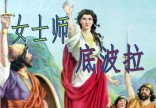 士师记第二课:底波拉士师:士师记第四章至第五章
士师记第二课:底波拉士师:士师记第四章至第五章
一。士师记4章:第三位伟大的士师:底波拉
迦南王名叫___ ___;他的将军是___ ___拉。作战时,耶宾王和西西拉的有利条件是什么?他们的军队包括___ ___九百辆。因此耶宾王“残暴地压迫以色列达二十年之久”[普通话本],使得以色列人___ ___耶和华
。底波拉是一位___ ___知。底波拉做什么?在哪里做?
底波拉奉神的名命令谁去跟耶宾王的将军西西拉作战?
7节:底波拉给巴拉很大的鼓励,说什么?
巴拉反应如何?
底波拉答应巴拉,但告诉他说他得不着荣耀。为什么?
雅亿是谁?
请把雅亿刺死西西拉的详细情况描述清楚。
二。士师记5章:底波拉之歌:
在底波拉之歌里,请选出底波拉所提到的,你认为比较有意思,比较容易读懂的事。
24-31节:请注意底波拉如何描绘西西拉被雅亿暗杀之故。虽然此首诗歌很古老,但这段话是典型希伯来人写的诗。以下的是希伯来人写诗之写法的简介:
1) 希伯来人的诗相当于中国人的对联;《圣经》的学者把它称为“平行体”(Hebrew Parallelism或翻为希伯来语并行)。恐怕底波拉不知道“平行体”这个词,但是解《经》家Robert Lowth于1753年用“平行体”这个词描述希伯来人写诗的写法。如果我们理解“平行体”是什么,它会帮助我们懂得《圣经》内容,特别是用“诗”来写的那部分《圣经》就约。诗篇、箴言、传道书等。以赛亚书、耶利米书、小先知书都是“诗”或有部分是用“诗”写的。
2) “平行体” (Hebrew Parallelism)分为三种也就是三个主要的写法,如下:
◊ “同义平行体”(Synonymous Parallelism):最普遍的平行体。前导和后导是同一个意思。后导重复前导。
◊ “组合平行体”(Progressive or Synthetic Parallelism):前导不完全,不完整,不单独存在;它需要后导补充。
◊ “反义平行体”(Contrasting or Antithetic Parallelism):前导和后导是相对的意思。
请按照以上所说的“平行体”的简介来解释士师记五章24至31节。
读者:欢迎您把这篇短文下载,复印,用在您的《圣经》班里。
Judges/02: Deborah
Judges chapters 4-5
1. Judges 4: The third great judge: Deborah: Who was the king of Canaan? The commander of his army was (whom). What advantage did king Jabin and commander Sisera have when they went to war? Their army included nine hundred (what). Consequently, king Jabin “cruelly oppressed the Israelites for twenty years” so that Israel c___ to the LORD. Deborah was a p___ss. What did Deborah do? Where? Who did Deborah command to go and make war on king Jabin and commander Sisera? Vs. 7: What did Deborah say that gave Barak a lot of encouragement? What was Barak’s reaction? Deborah said OKAY but told him that he would not receive the honor. Why? Who was Jael? Describe in detail how Jael killed Sisera.
2. Judges 5: The Song of Deborah: Select several events mentioned in the Song of Deborah that you think are more interesting and easier to understand. Vs. 24-31: Note Deborah’s description of how Jael murdered Sisera. Even though this poem is very ancient, these verses are typical Hebrew poetry. Below is a brief introduction to Hebrew poetry.
1) The way Hebrews write poetry is very similar to the way Chinese write “couplets” [such as are written on door frames at Lunar New Year]. Bible scholars call this form “Hebrew Parallelism.” Deborah probably did not know the term “Hebrew Parallelism,” but Bible scholar Robert Lowth, in 1753, used it to describe the way Hebrews wrote poetry. Understanding “parallelism” helps us understand those parts of the Bible that are poetry, e.g., Psalms, Proverbs, Ecclesiastes, etc. Isaiah, Jeremiah and the Minor Prophets are written in poetic form or include poetry.
2) There are three basic types of Hebrew Parallelism:
◊ Synonymous Parallelism: This is the most common form of Hebrew Parallelism. The first clause or line and the second mean the same thing; the second line repeats the first line.
◊ Progressive or Synthetic Parallelism: The first line is incomplete and does not stand alone; the first line supplements the second line.
◊ Contrasting or Antithetic Parallelism: The second clause (line or thought) gives an opposite meaning of the first line.
Use the introduction to Hebrew poetry above to explain Judges 5:24-31.
圣经问答
士师记第二颗:底波拉士师:士师记第四章至第五章
Bible Study Questions: Judges/02: Deborah
Judges 4-5
作者:谢德华 ©By Edward Short
本文所问的问题使用汉子圣经。
欢迎您把此文下载用在圣经班或私人学习。
A series of Bible lessons, written in Chinese
and based largely on the text of the Chinese Bible.
You may download and print copies of this lesson
for use in your Bible class.
